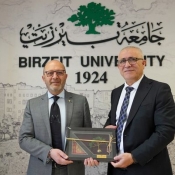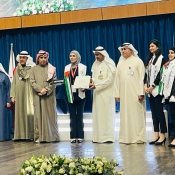Physics Seminar on 'Unconventional Dark Matter'
The Physics Department at BZU held a physics seminar titled: ‘Unconventional Dark Matter' on 12 January 2011, in which Professor Per Osland from the Institutt for fysikk og teknologi, University of Bergen, Norway, has participated.
The seminar was attended by audience from interested faculty members and students at BZU. In his talk, Professor Osland started by a review on some of the evidence for Dark Matter which can not be detected by our primary means of observation since it neither emits nor absorbs light. Astrophysical evidence states that 85% of the Universe is composed of Dark Matter which can be observed by its gravitational effect on orbits of stars and galaxies and on bending the path of light.
Yet, the exact nature of Dark Matter is not clear to us. Physicists proposed many different scenarios on what kind of particles might make up Dark Matter. Most of the current focus for explaining it is on a version of a theory called 'Supersymmetry', which provides an invisible particle that is absolutely stable (i.e. it does not decay into other particles), called 'Neutralino'. Such particles are searched for in experiments where they might scatter (giving a recoiling atomic nucleus) or annihilate pairwise, giving photons or antimatter as Osland illustrated. One also hopes to produce these particles at the Large Hadron Collider (LHC) at CERN (The European Organization for Nuclear Research) which started to operate in 2008.
Motivated by an excerpt from Albert Einstein ``Imagination is more important than knowledge`` and the fact that Dark Matter needs not be absolutely stable, it is sufficient that its lifetime is long compared to the age of the Universe, Osland discussed a scenario where a particle called 'Gravitino' can be another candidate as a Dark Matter particle. He also explained new results his research collaborators and himself published on the decay products of the Gravitino where the photon spectrum is consistent with measurements from various experiments such as the experiment known as PAMELA and FERMI LAT. Toward the end of his talk, Professor Osland explored few other scenarios and ideas on Dark Matter which are still to be tested in the near future, most likely at the experiments of the Large Hadron Collider (LHC) at CERN.
This is the second visit of professor Osland to the Physics Department at BZU after his first visit in October 2004 when he gave two interesting talks on topics in the field of particle physics. The visit was coordinated by Dr. Wafaa Khater from the physics department who collaborated with professor Osland on scientific research projects in the field of particle physics.






